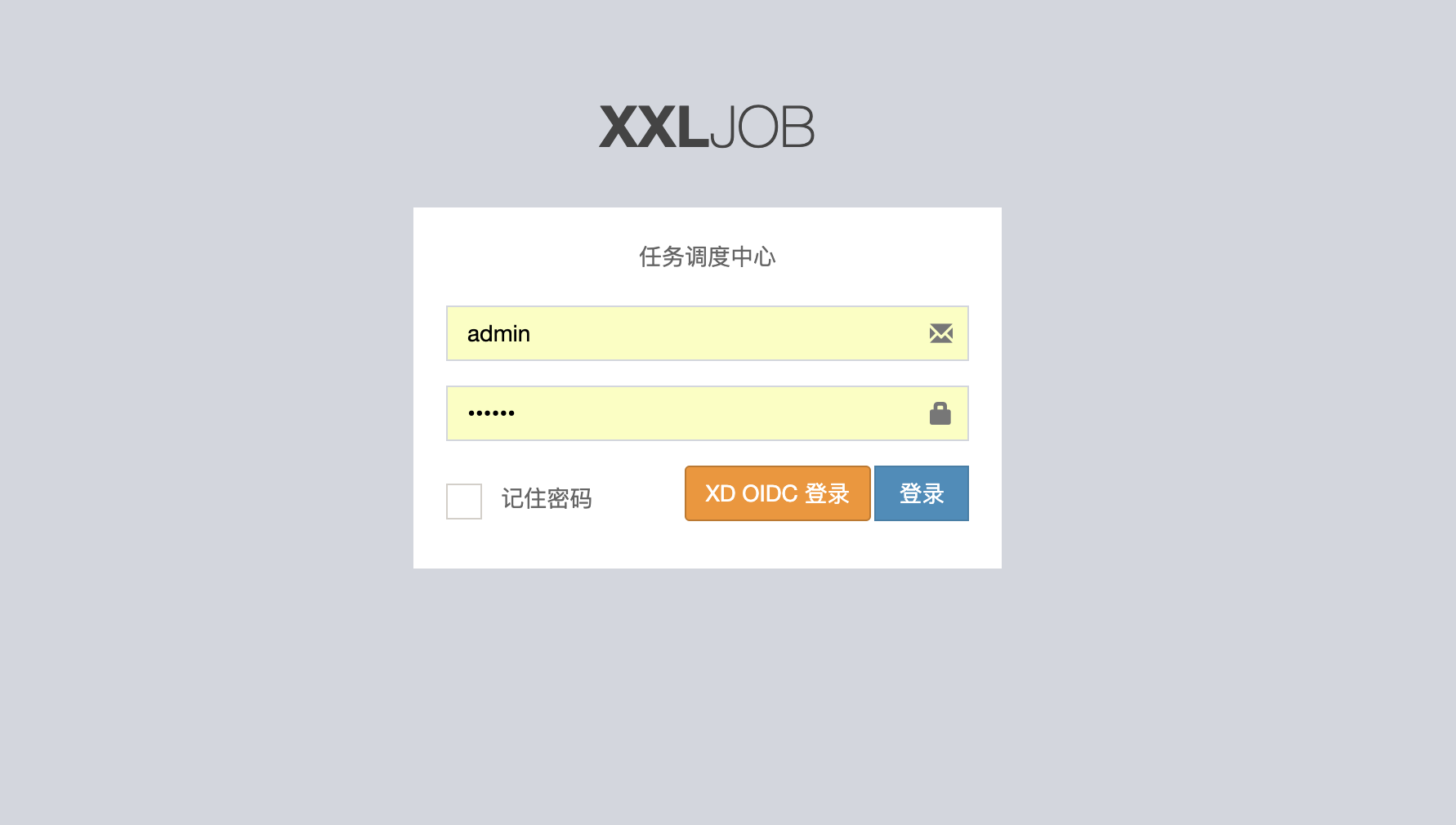前言
xxl-job 是一款 java 開發的、開源的分佈式任務調度系統,自帶了登錄認證功能,不支持對接、擴展 LDAP 、OIDC 等標準認證系統,考慮到單獨維護 xxl-job 自有的用戶系統不方便,以及存在人員離職、調崗、權限變動等需要及時調整用戶權限的情況,需要接入公司統一的 OIDC 認證系統
相關鏈接
- xxl-job :https://github.com/xuxueli/xxl-job
- oidc :https://openid.net/connect/
xxl-job 自身認證功能分析
xxl-job 自帶的登錄認證用戶信息維護在 mysql 的 user 表中,用戶從登錄頁提交用戶名和密碼,後端查詢用戶信息、校驗密碼,驗證成功後設置登錄信息到 cookie 中,採用 cookie 保持登錄狀態,大致的流程如下:

OIDC 的認證流程
OIDC(OpenID Connect) 是一種融合了 OpenID 、Oauth2 的身份認證協議。認證流程上和 Oauth2 基本一致,但是,OIDC 在 Oauth2 的 access\_token 基礎上新增了一個使用 jwt 生成的 idToken,idToken 中攜帶了用戶基本信息,使用私鑰驗籤成功後,可直接使用,省略了通過 access\_token 獲取用戶信息的步驟。所以 OIDC 的認證流程既和 Oauth2 類似又有區別,基本流程如下:
- 客戶端準備包含所需請求參數的身份驗證請求。
- 客戶端將請求發送到授權服務器。
- 授權服務器對終端用戶進行身份驗證。
- 授權服務器獲得終端用戶同意/授權。
- 授權服務器將 code 發送回客戶端 。
- 客戶端將 code 發送到令牌端點獲取 access_token 和 idToken。
- 客戶端使用私鑰驗證 idToken 拿到用戶標識 or 將 access_token 發送到授權服務器獲取用戶標識。
這裡注意最後第 6、7 點操作,這裡開始 OIDC 和 Oauth2 不一樣了
xxl-job 集成 OIDC 後的認證流程
從 OIDC 的認證流程得知,終端用戶通過授權服務器授權認證後,授權服務器會攜帶 code 重定向到客戶端服務,客戶端通過 code 可以拿到用戶唯一標識,通過這個唯一標識,可以繼續完成客戶端原本的認證流程。集成 OIDC 後,xxl-job 登錄的大致流程如下:

集成 OIDC 後,系統認證保持用戶登錄狀態的機制沒有變化,依然使用 Cookie ,需要特殊處理以及關注地方有:
- 用戶首次登錄系統,由於不存在系統中,需要先創建用戶
- 如果系統首次投產使用,記得設計一個可以從配置指定管理賬戶的功能,不然你得手動改數據庫了
- 如果系統運行很久了,需要考慮好原系統用戶和 OIDC 授權用戶的映射關係
- 退出操作時,除了清除自身的用戶登錄狀態,是否退出 OIDC 服務(實現 sso)的登錄狀態也需要考慮
xxl-job 登錄模塊重新設計
考慮開發環境使用 OIDC 服務不方便以及解耦對第三方認證授權服務的依賴,決定在集成 OIDC 時,兼容本地登錄功能,登錄流程由登錄模式來控制區分,登錄模式使用配置驅動,設計集成 OIDC 後 ,xxl-job 支持的登錄模式如下:
- onlyLocal :只支持 xxl-job 自身用戶系統登錄認證
- onlyOidc : 只支持 Oidc 授權服務器授權登錄認證
- mix :混合模式,同時支持自身用戶系統登錄認證、Oidc 授權服務器授權登錄認證
onlyLocal 模式登錄界面:

mix 模式登錄界面:

olnyOidc 模式登錄界面:
olnyOidc 模式特殊,從設計上來說,如果需要保留用戶使用習慣,可以保留一個跳轉到 OIDC 授權服務器的鏈接按鈕給用戶點擊。如果做的乾淨利落,在 olnyOidc 模式下,訪問登錄頁可以直接 302 到 OIDC 授權服務器。
保留登錄按鈕的界面(實際這個頁面取消了)

編碼環節
配置屬性類,省略了get、set
/**
* @author kl (http://kailing.pub)
* @since 2021/6/21
*/
@ConfigurationProperties(prefix = "oidc")
@Configuration
public class OidcProperties {
private static final LoginMod DEFAULT_LOGIN_MOD = LoginMod.onlyLocal;
private LoginMod loginMod = DEFAULT_LOGIN_MOD;
private String clientId;
private String clientSecret;
private String accessTokenUrl;
private String profileUrl;
private String redirectUri;
private String logoutUrl;
private String loginUrl;
private List<String> adminLists = new ArrayList<>();
public enum LoginMod {
mix,
onlyOidc,
onlyLocal
}
}對應瞭如下的配置, 除了 login-mod 、redirect-uri 、admin-Lists 是 xxl-job 自身登錄功能需要,其他的配置均由 OIDC 授權服務器提供
oidc.login-mod=onlyOidc
oidc.client-id = xxl-job-dev
oidc.client-secret = xx
oidc.base-url = https://sso.security.oidc.com
oidc.access-token-url = ${oidc.base-url}/cas/oidc/accessToken
oidc.login-url = ${oidc.base-url}/cas/oidc/authorize?response_type=code&client_id=${oidc.client-id}&redirect_uri=${oidc.redirect-uri}&scope=openid
oidc.redirect-uri = http://172.26.203.103:8071/oidc/tokenLogin
oidc.logout-url =${oidc.base-url}/cas/logout?service=${oidc.redirect-uri}
oidc.admin-Lists = chenkailing
Oidc 服務類,使用這個類裡的方法和 OIDC 授權服務器交互
/**
* @author kl (http://kailing.pub)
* @since 2021/6/21
*/
@Service
public class OidcService {
private final OidcProperties oidcProperties;
private final RestTemplate restTemplate;
public OidcService(OidcProperties oidcProperties, RestTemplate restTemplate) {
this.oidcProperties = oidcProperties;
this.restTemplate = restTemplate;
}
/**
* 請求 OIDC 授權服務器,獲取 idToken
* idToken 中包含的信息 (非標準)
* {
* "sub": "248289761001",
* "name": "Jane Doe",
* "given_name": "Jane",
* "family_name": "Doe",
* "preferred_username": "j.doe",
* "email": "[email protected]",
* "picture": "http://example.com/janedoe/me.jpg"
* }
*/
public String getUsernameByCode(String code) {
URI uri = UriComponentsBuilder.fromUriString(oidcProperties.getAccessTokenUrl())
.queryParam("client_id", oidcProperties.getClientId())
.queryParam("client_secret", oidcProperties.getClientSecret())
.queryParam("redirect_uri", oidcProperties.getRedirectUri())
.queryParam("code", code)
.queryParam("grant_type", "authorization_code")
.build()
.toUri();
AuthorizationEntity auth = restTemplate.getForObject(uri, AuthorizationEntity.class);
Assert.notNull(auth, "AccessToken is null");
String idToken = auth.getIdToken();
int i = idToken.lastIndexOf('.');
String withoutSignatureToken = idToken.substring(0, i+1);
return Jwts.parserBuilder()
.build()
.parseClaimsJwt(withoutSignatureToken)
.getBody()
.get("sub", String.class);
}
/**
* @return 1 : 管理員 、0 : 普通用戶
*/
public int getUserRole(XxlJobUser user) {
List<String> adminLists = oidcProperties.getAdminLists();
if (adminLists.contains(user.getUsername())) {
return 1;
}
return 0;
}
public String getOidcLoginUrl() {
return oidcProperties.getLoginUrl();
}
public OidcProperties.LoginMod getLoginMod() {
return oidcProperties.getLoginMod();
}
public boolean isRedirectOidcLoginUrl() {
return oidcProperties.getLoginMod().equals(OidcProperties.LoginMod.onlyOidc);
}
public String getLogoutUrl() {
return oidcProperties.getLogoutUrl();
}
static class AuthorizationEntity {
@JsonProperty("access_token")
private String accessToken;
@JsonProperty("id_token")
private String idToken;
@JsonProperty("refresh_token")
private String refreshToken;
@JsonProperty("expires_in")
private String expiresIn;
@JsonProperty("token_type")
private String tokenType;
private String scope;
}
}OIDC 登錄接口,也就是提供給 OIDC 授權服務器回調的接口
/**
* OIDC登錄
*/
@RequestMapping(value = "/oidc/tokenLogin", method = {RequestMethod.POST, RequestMethod.GET})
@PermissionLimit(limit = false)
public ModelAndView loginByOidc(HttpServletRequest request, HttpServletResponse response, ModelAndView modelAndView) {
if (loginService.ifLogin(request, response) != null) {
modelAndView.setView(new RedirectView("/", true, false));
return modelAndView;
}
String code = request.getParameter("code");
if (Objects.isNull(code)) {
return this.loginPageView();
}
String username = oidcService.getUsernameByCode(code);
loginService.oidcLogin(username, response);
modelAndView.setView(new RedirectView("/", true, false));
return modelAndView;
}
這個接口對應了 xxl-job 集成 OIDC 後的認證流程:
- 判斷是否登錄,已經登錄則跳轉到登錄成功的頁面
- 獲取 code ,不存在則調整到登錄頁面
- 通過 code 請求 OIDC 授權服務器獲取 UserInfo
- 處理內部登錄邏輯(用戶是否存在,存在則設置 Cookie,不存在則先創建用戶在設置 Cookie)
- 跳轉到登錄成功的頁面
跳轉登錄頁邏輯做了封裝,因為,根據登錄模式的不同,有不同的處理邏輯:
private ModelAndView loginPageView() {
ModelAndView modelAndView = new ModelAndView(LOGIN_PAGE);
if (oidcService.isRedirectOidcLoginUrl()) {
modelAndView.setView(new RedirectView(oidcService.getOidcLoginUrl(), true, false));
} else {
modelAndView.addObject("loginMod", oidcService.getLoginMod().name());
modelAndView.addObject("oidcLoginUrl", oidcService.getOidcLoginUrl());
}
return modelAndView;
}
目前的策略,如果配置了登錄模式為 onlyOidc ,則跳轉登錄頁時,直接 302 到 OIDC 授權頁,否則,將登錄模式,和 OIDC 授權頁傳遞給前端,由前端控制展示的 UI